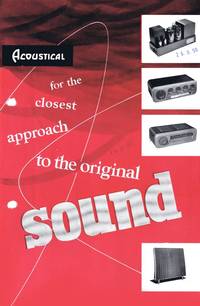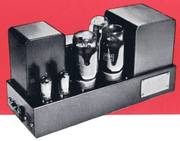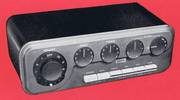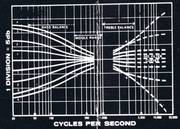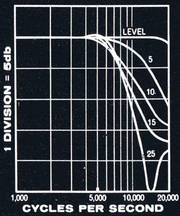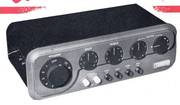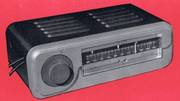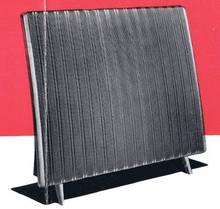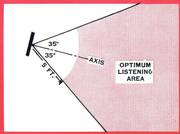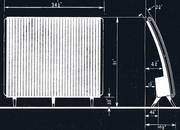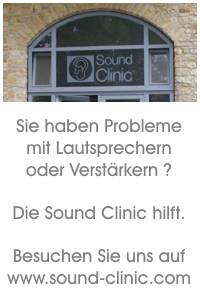Ein uralter englischer original Prospekt aus 1959
Im Nachlass des Wolfgang Hasselbach sind ganz besondere "Stücke" enthalten - unter anderen Broschüren über (zum Beispiel) Cabasse aus Frankreich - so auch diese QUAD Produktübersicht aus dem August 1959.
BRAUN aus Frankfurt hatte ja bei Mister Walker die Fabrikations-Lizenzen für 500 Paare der BRAUN LE1 Elektrostaten erworben (und damit Schiffbruch erlitten). Mr. Walker war gegen deutsches Geld nicht abgeneigt, wollte aber weiter kein Wissen rausrücken, schon gar nicht an die Deutschen. Herr Hasselbach war mit seinen Problemen im Gepäck mehrfach dort in England, holte sich aber fast jedes Mal galant und höflich eine indirekte Abfuhr. Mr. Walker hätte vom Alter her sein Vater sein können. So war das damals 15 Jahre nach dem 2. Weltkrieg.
.
ACOUSTICAL - for the closest approach to the original sound
Das war das Cover-Logo auf dem 1959er QUAD Prospekt. Um 1959 herum kam auch in England der Umschwung auf Stereo bei Schallplatten und Bandgeräten. Der QUAD Tuner wurde erst später auf Stereo nachgerüstet.
.
The QUAD II power amplifier (Mono)
The QUAD II power amplifier contains no controls and may therefore be mounted inside the cabinet, leaving only the control unit panel (and that of the radio tuner if fitted) visible on the outside. Stability, and hence performance are entirely independent of signal or load conditions and the amplifier is therefore suitable for use with any loudspeaker arrangement. The performance specification is fully maintained with random replacements from normal valve stocks without the need for matching or alignment of any kind, and the output stage uses the now traditional QUAD cathode coupled arrangement combining low distortion with an efficiency which is reflected in the compact size of the equipment. The amplifier is suitable for use in all climatic conditions.
.
The QUAD II power amplifier specs
POWER OUTPUT
15 watts throughout the range 20-20,000 c/s.
INPUT
Sensitivity: MV.rms for 15 watts output. Load Imposed on input: 1.5 MQ In parallel with 10 pF.
FREQUENCY RESPONSE
Within 0.2dB 20-20,000c/s. Within 0.5 dB 10-50,000 c/s.
DISTORTION (measured at 12 watts output)
Total third and higher order: less than 0.1% at 700 c/s.
Higher order alone: less than 0.03% at 700 c/s.
Valve mismatching up to 25%
(introducing 2nd harmonic) not to cause distortion to exceed 0.18%.
Total distortion at 25 c/s not to exceed 0.25%.
BACKGROUND
80dB referred to 15 watts.
OUTPUT IMPEDANCE 15ft and 7Q
Effective output resistance: I ft for 15ft output.
POWER SUPPLIES
Input: 200-250v AC single phase (or 95-125v AC) 40-80 c/s.
90 watts consumption (excl. control unit, tuners, etc)
Valves: 2x EF.86 (Z.729 or 6267), 2x KT.66 (5883 or 6L6G matched), I x GZ.32 (54KU or 5V4G.)
WEIGHT !8± lbs. (8.3 Kg.) DIMENSIONS I3"x4}"x6£".
MECHANICAL
All windings are impregnated and housed in compound filled casings. All metal work fully rust-proof processed and stoved steel grey. Metal work, rust-proofing, finishing, transformer winding, tropicalisatlon, assembly and tests are all carried out under the constant supervision of our AID approved inspection section. The equipment is suitable for use under all climatic conditions.
The QUAD 22 control unit (Stereo)
The QUAD 22 control unit is designed to operate with two QUAD II power amplifiers - but it may be used with one only for monaural operation if required. Selection of stereo or monaural is by push buttons, as also are the choice of programme and record equalisation characteristic.
The other front panel controls are all equally straigt-forward in operation and yet comprehensive in ???? providing all that is necessary in an amplifier for the closest approach to the original sound so that enjoyment of the music is not impeded by problems of manipulation.
The curves illustrated opposite show the slopes of response provided by the bass and treble controls, and the manner in which the filter may be adjusted to provide the widest possible frequency range consistent with minimum distortion in each programme source. In the cancel position there is a useful reference standard for comparison with the settings of the bass, treble and filter controls found by aural assessment, and the balance control provides for adjustment of balance between stereo channels.
The gramophone input may be accurately matched to any pickup by choice of the correct plug-in adaptor unit, indicated on a chart supplied with the amplifier, while another chart shows the push button combinations required to provide correct equalisation for different makes of record, old and new.
The QUAD 22 control unit specs
FREQUENCY RESPONSE
Cancel position:
Radio and Tape inputs: 20-20,000 c/s ±0.5dB.
Microphone: 20-20,000 c/s ±2 dB.
Gramophone Maintained over 20-20,000 c/s withini 1dB
Bass and treble controls: ±1.5 dB of published curves.
Filter frequencies: 5 Kc/s, 7 Kc/s, 10 Kc/s.
Filter slope: See curves.
INPUT SENSITIVITY (at 1 Kc/s for 1.4V rms output)
Radio: 70 mV rms. Load impedance 100,000 ohms.
Tape: 70 mV rms. Load impedance 100,000 ohms.
Microphone: 1.5 mV rms. Load impedance 100,000 ohms.
Pickup: Depending upon adaptor unit.
Basic sensitivity prior to compensation 400 mV rms.
DISTORTION (1.4 Vrms output): All controls level: Any input: 0.02%. Least favourable arrangement of controls: /ess than 0.1%.
NOISE
Total hum and noise: Better than -70 dB.
Noise: -80 dB or where applicable, the equivalent noise of the pickup load impedance at the input.
OUTPUT
Control unit to power amplifier: 1.4 V rms.
Tape outputs: Peak signal approx. 0.25 V rms.
Maximum loading 500,000 ohms and 200 pF.
INTERCHANNEL SPECIFICATION
Cross talk: Better than 40dB 20-20,000 c/s.
Gain stability: With any volume setting and tone controls level: Less than 1dB between channels. With any volume setting and tone controls varied: Less than 2dB between channels.
Balance control: Provides up to 9dB unbalance either way.
POWER SUPPLY
The unit takes its power from the main amplifier as follows :
220V - 4mA. Plus current taken by tuner units.
VALVES
2 x EF86 (Z.729 or 6267). 2 x ECC83 (I2AX7).
MECHANICAL
Front panel: Die cast, stove finished silver fawn.
Knobs: Matt brown. -Chassis: Steel: Cadmium plated. - Cover: Steel: Stoved steel grey.
The complete unit is electrically and mechanically suitable for use in all climatic conditions.
.
The Quad II Control Unit (Mono)
The Quad II Control Unit is the monaural counterpart of the Quad 22 and is very similar in all the main features except, of course, for those associated exclusively with stereo.
The Quad II Control Unit specs
FREQUENCY RESPONSE
Cancel position-Radio & Tape inputs, 20-20,000 c/s within 0.3 dB:
Microphone input, 20-18,000 c/s within I dB: Pickup input; with R.2, within 0.5 dB of stated characteristics; with other adaptors no magnificant change,
Bass and Treble controls: Within 1 dB of curves
Filter frequencies: 5 Kc/s, 7 Kc/s, 10 Kc/s ± 250 c/s.
Filter slope: Level to 50 dB/Octave.
INPUT SENSITIVITIES (for 1.4 V.rms output)
Radio and Tape: 100 mV at 100 KQ
Microphone: 1.5 mV at 100 KQ.
Pickup: Depending upon adaptor unit.
DISTORTION (1.4V output)
All controls 'level', Radio input or R.2 pickup input: 0.02% approx. Least favourable arrangement of plugs and controls: less than 0.1%. Permissible input overload: Radio-immaterial.
Pickup-according to adaptor unit used.
VALVES
I x EF.86 (Z.729 or 6267), I xECC.83 (I2AX7).
POWER SUPPLY
The unit takes its power from the main amplifier.
220V - 2mA and 6.3 V 1A: Plus currents taken by tuner units which may be connected to sockets provided.
Maximum power available from tuner sockets: 330 V 35 mA
each tuner (switched), 6.3 V 3 A total (not switched).
The heater supply is C.T. to chassis.
BACKGROUND
70 dB or where applicable, approximately 6 dB above equivalent thermal noise of input impedance. Mechanical and Dimensional details similar in every respect to Quad 22 Control Unit.
The QUAD FM Tuner
In the QUAD FM Tuner careful control of the bandwidth throughout the receiver makes it possible to obtain low distortion and high noise rejection while the limitation of frequency response is that imposed by the transmitter rather than the receiver assuming correspondingly good amplifiers and loudspeakers.
The QUAD FM Tuner specs
DRIFT
As drift is quite important at the frequencies used for FM, temperature compensation and AFC have been incorporated to ensure that the QUAD FM Tuner really stays on tune.
TUNING INDICATOR
A unique display has been developed giving a positive indication of accurate tuning, with the advantage over conventional types that it is not necessary to detune the receiver to check whether or not it was on tune! This indicator shows a tuning error of 1 part in 10,000.
TUNING
A precision mechanism prevents tuning error due to backlash and provides a smooth and accurate control.
DIAL
The dial shows the frequency range of the receiver (87.5 to 108 Mc/s) covering both British and American bands, and adjustable Station Indicators, set to the scale settings corresponding to local stations, enables programmes to be selected without difficulty.
MOUNTING
The mounting arrangements are of the same design as other units in the QUAD series, combining simplicity and rigidity with a "clean" finish.
CONNECTIONS
Each tuner is supplied with leads and plugs for direct connection to the QUAD 22 control unit, which provides the necessary power supplies, but the Tuner may be used with other amplifiers if desired.
AERIAL
The strength of signal to be expected in any area will depend on the distance from the transmitter and the nature of the terrain between transmitter and receiver. The QUAD FM Tuner is suitable for use in fringe areas, but the type of aerial will depend mainly on the locality, and the local dealer will be in the best position to advise on this matter.
TUNING RANGE
87.5- 108 Mc/s.
SENSITIVITY
3uV for 20 dB quieting.
OUTPUT
100 mV at 100,000 ohms impedance (to be terminated by 100,000ohms across amplifier input).
CONSUMPTION
6.3 v 1.85 A; 330 v 27 mA.
VALVES
6BJ6; I2AT7/ECC 81; 6BIH6; 6BH6; 6AU6; 6AL5/EB9I; I2AX7/ECC83; neons Hivac COIL; lamp 6.5v 0.3A.
FRONT PANEL
Die cast, stove finished silvered fawn.
KNOB
Aluminium, stove finished matt brown.
DIAL
{" perspex, machine engraved, filled white and red, and finished gold on a matt brown background.
DIMENSIONS I0i"x34">:6".
WEIGHT 6 lbs. (2.7 Kgs.)
THE QUAD ELECTROSTATIC LOUDSPEAKER (ESL-57)
THE QUAD ELECTROSTATIC LOUDSPEAKER is a design of modest size intended for the highest grade of music listening under domestic conditions. It is suitable in rooms from 1,000 to 5,000 cubic feet, and is capable of providing distortionless reproduction under such conditions up to a volume level similar to that experienced in the concert hall.
It is designed with every emphasis towards the natural, non-fatiguing and unobtrusive quality desirable for serious listening to music of all types. There is no doubt that the very unobtrusiveness of the speaker will seem an anticlimax to many people because of the complete absence of "spectacular Hi-Fi." For the rest, there will be a degree of naturalness which has given rise to such expressions as "Freshness," "Relaxed," "Transparent," "Window on the Orchestra."
The loudspeaker is supplied complete with built-in networks for operation direct from a low impedance amplifier source and incorporates its own polarising supply ready for connection to AC mains.
The loudspeaker is intended to be used with a standard QUAD II amplifier. Other amplifiers may be used provided they are designed or adapted to meet the specific parameters given on this page. Failure to meet this requirement will result in inferior performance or unreliability.
SPECIFIC AMPLIFIER REQUIREMENTS
.
- 1. When adjusted to a fixed suitable output tap, the amplifier should be capable of delivering at least 15 watts at low distortion when a resistive load is varied between 30 ohms and 7 ohms.
- 2. The amplifier must be statically and dynamically stable completely regardless of the resistance or reactance of the load. An inductance of up to l0uH may be inserted in series with the load during these tests.
- 3. With a 30 Ohm resistive load, the amplifier should at no time be capable of producing more than 35 peak volts across the loudspeaker terminals,
- 4. The source impedance of the amplifier should be not more than 2 Ohms in the frequency range 100-5.000 c/s and not more than 6 ohms in the range 40-20,000 c/s. Ideally this impedance should be equivalent to a 1-2 ohm resistor in series with a 40uH inductance.
.
POSITION
The loudspeaker is free standing and does not require the use of a corner position. Position is, in fact, not critical, except that this speaker should not be operated closer than 2 feet from any wall or large surface parallel to the plane of the loudspeaker. Both front and back radiation should be as unrestricted as possible.
Good musical balance will be obtained when the listener is seated in the area covered by an angle of nearly 90° symmetrical to the front of the loudspeaker.
ELECTROSTATIC LOUDSPEAKER specs
TEMPERATURE, HUMIDITY
The loudspeaker will withstand a temperature of up to 45° C. and is thus unaffected by normal domestic temperature. The loudspeaker will operate indefinitely with Relative Humidities of up to 90% and will safely withstand reasonable periods of up to 100% RH. If, however, temperature and humidity conditions are sufficiently severe and prolonged that moisture is able to precipitate inside the loudspeaker, then damage is likely to result. This may preclude the use of the loudspeaker under certain tropical conditions. The loudspeaker is completely sealed in plastic film and is immune from the effects of dust.
SPECIFICATION
MAXIMUM OUTPUT
6' on axis In free space 93 dB referred to .0002 dynes/cm2 in frequency range 50c/s - 10Kc/s.
l00dB referred to .0002 dynes/cm2 in range 70c/s - 7Kc/s.
Total Integrated radiation equivalent to 95 phons in enclosures up to 5,000 cubic feet with average reverberation.
BANDWIDTH
45c/s - 18Kc/s. Rate of attenuation asymptotic to 18 dB/8ve.
DISPERSION
Approximately 70° Horizontal, 15° Vertical.
IMPEDANCE
30-15 Ohm in range 40c/s - 8Kc/s falling above 8Kc/s (see power amplifier requirements).
AC POWER CONSUMPTION
Negligible. ( = vernachlässigbar)
AC VOLTAGE RANGE
100-120, 200-250 volts 50-60 c/s.
DIMENSIONS
See drawing.
WEIGHT
Net 39 lbs. (17.7 Kilos approx.)
PRICES
(Preise im Herbst 1959 in England) :
PRICES (Applicable to United Kingdom only)
QUAD II POWER AMPLIFIER 22.-
QUAD II CONTROL UNIT 19.-
QUAD 22 CONTROL UNIT 25.-
QUAD F.M. TUNER 21.-
QUAD ELECTROSTATIC LOUDSPEAKER 52.-
(alle Preise in Pound Sterling) + tax
The ACOUSTICAL MANUFACTURING COMPANY LTD.
HUNTINGDON, HUNTS.
Telephone: HUNTINGDON 361
.

